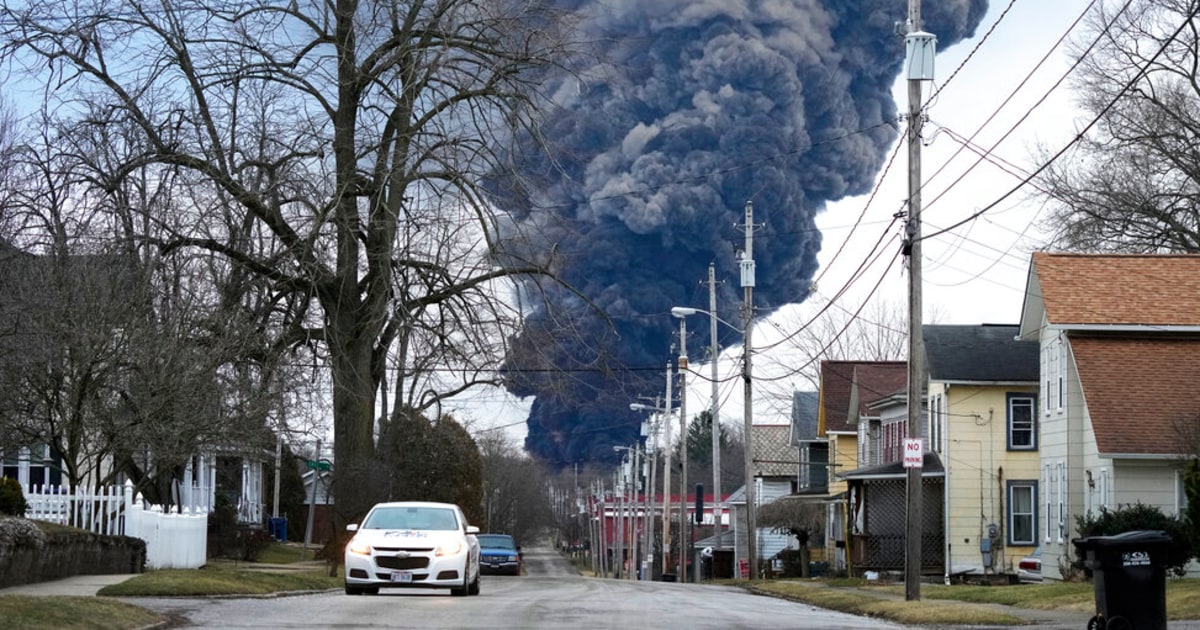By Erika Edwards -
NBC News
This Saturday, at a busy drive-thru McDonald's in East Palestine, Ohio, a team of epidemiologists, environmental health scientists and others were outside handing out flyers.
Each brochure has a survey with a QR code that provides information on how to contact health officials.
Three weeks after a massive train derailment spewed toxic, cancer-causing fumes into the area, Centers for Disease Control and Prevention (CDC) personnel tour high-traffic areas of the city. town, encouraging residents to talk about their symptoms and long-term health fears.
[“I'm scared to be here”: Ohio residents near derailment report bronchitis and other illnesses associated with chemical exposure]
"We really want to make sure that we're targeting any potentially affected residents," Jill Shugart, a senior environmental health specialist with CDC's Agency for Toxic Substances and Disease Registry, said in an exclusive interview with NBC News. sister of Noticias Telemundo.
Shugart leads the federal agency response in East Palestine.
As the disaster cleanup continues, residents and those living around the small Pennsylvania border town remain terrified that the chemicals in a thick plume of smoke that blanketed the area are harming their health.
Some were diagnosed with bronchitis and others developed nausea, rashes, itchy eyes and other unexplained symptoms.
A black column rises over eastern Palestine, following the controlled detonation of part of the derailed Norfolk Southern trains on February 6. Gene J. Puskar / AP
“I've had a scratchy throat like everyone else,” said Mike Zelenak, a business owner in East Palestine.
"It gives me a headache".
Zelenak owns property near the accident site and is concerned about the risks of long-term illness.
Stories like Zelenak's are exactly the kind of information the CDC should be collecting, but on a much larger scale.
CDC staff, along with representatives from the Environmental Protection Agency, FEMA, the federal Department of Health and Human Services, and local government, are working to contact and learn of anyone whose health may have been affected by the consequences of the derailment.
It's like putting together a puzzle."
Jill ShugarT, ENVIRONMENTAL HEALTH SPECIALIST, AGENCY FOR TOXIC SUBSTANCES AND DISEASE REGISTRY
The surveys include “questions like demographics, where residents live, what kind of health effects they might be experiencing, and trying to come up with a timeline of when they may have been in the area when the incident occurred,” Shugart said.
"It's like putting together a puzzle."
The response so far, the CDC reported, has been positive.
[What chemicals were released from the Ohio train derailment and how could they harm the health of residents?]
This effort is expected to move to Pennsylvania in the coming days, with the agency also focusing on the health of first responders at the derailment scene.
The questionnaires take about 30 minutes per person and data collection could continue for up to two weeks, authorities said.
That suggests that the first answers from the CDC probably won't be available until more than a month after the derailment.
What are the health risks from exposure to chemicals?
When the Norfolk Southern train derailed on February 3, a highly flammable chemical called vinyl chloride caught fire and began spewing a large cloud of smoke.
The material used to make pipes and packaging materials made of polyvinyl chloride or PVC.
It is also used in the manufacture of vehicle upholstery, which produces that "new car smell".
Aerial photo taken on February 19 showing the site of the Norfolk Southern train derailment as cleanup crews carried out their work in East Palestine, Ohio.
Tannen Maury / EFE
The EPA explained that when inhaled in large amounts, vinyl chloride increases the risk of liver cancer.
The CDC can only deploy to areas of the country when states formally request the agency's help.
Shugart said his team received requests from the Ohio and Pennsylvania health departments two weeks after the derailment and was mobilized within days.
CDC staff said they have not yet taken any unusual safety precautions in the area.
The team is staying at a hotel 30 miles from East Palestine, in Cranberry Township, Pennsylvania.
They say they are drinking the tap water in the hotel.
[Hazardous chemical train issued critical alert for overheating axle just before derailing in Ohio]
Meanwhile,
"people are anxious and very concerned
," said Dr. Maureen Lichtveld, dean of the University of Pittsburgh School of Public Health.
Lichtveld, who previously worked with the Agency for Toxic Substances and Disease Registry, said it's critical that public health teams engage the community by listening to residents' concerns and being clear about their action plans.
Community members need to be “part of whatever action we take, part of how to design that action, how to implement that action and disseminate the information,” Lichtveld said.
“That is a tremendously important step to reduce the stress that currently exists,” he added.

